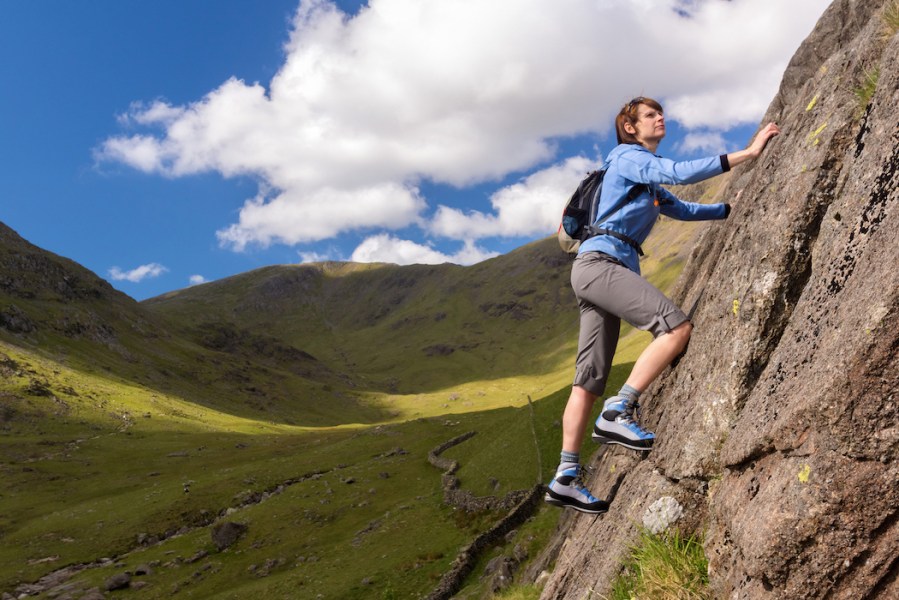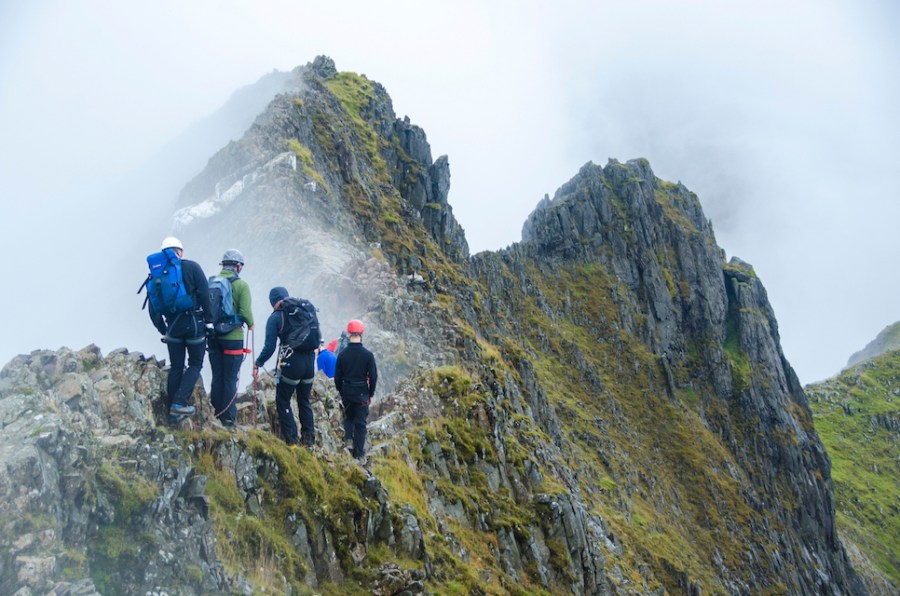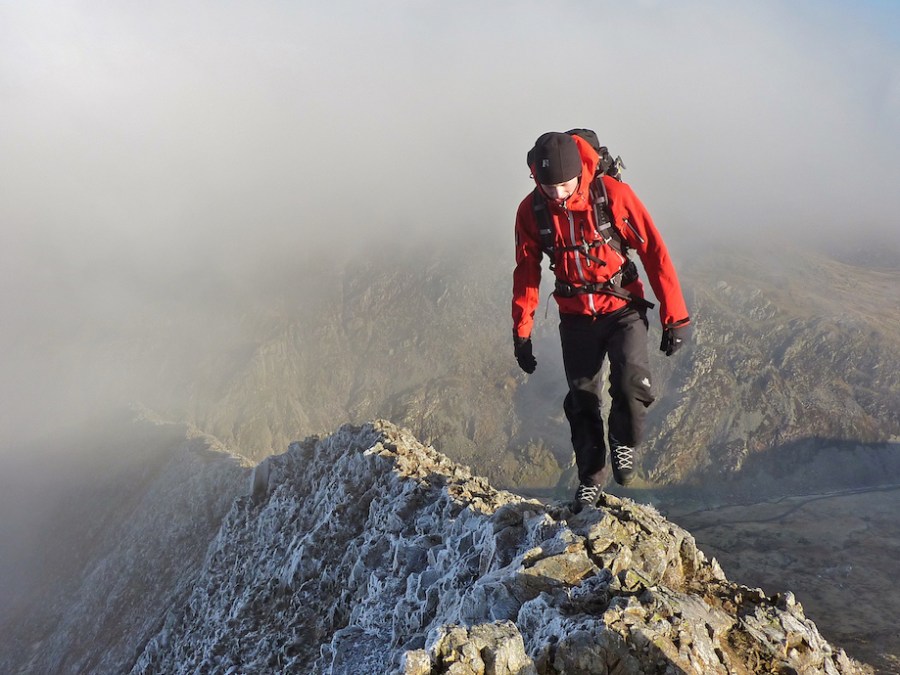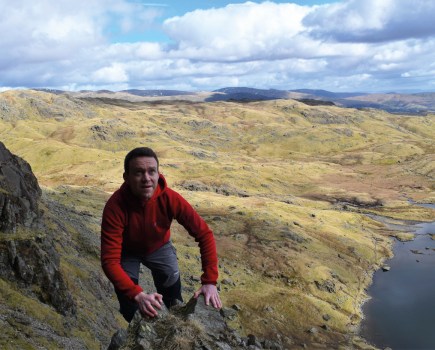Conquer your fear of heights! If you want to improve your confidence over exposed ground and technical scrambles, here are some steps you can take to fight the fear…
Fear of heights is not something that we’ve only recently run into. In 1802 Romantic poet Samuel Taylor Coleridge, a friend of William Wordsworth, took the ‘wrong way’ off Scafell in the Lake District and made an accidental descent of Broad Stand, an experience that “put my whole limbs in a tremble, and…I began to suspect that I ought not to go on.” He “shook all over”, began to “laugh at myself for a madman” and fixated on falling backwards off a narrow ledge to his death.
More than two centuries later, hillwalkers of all ages, genders and levels of experience can still relate to Coleridge’s fears and anxieties. There is nothing abnormal, however, about a fear of heights. It is a natural, evolutionary instinct important to survival – but it affects some people more than others. As its worst, it can prevent some hikers from achieving their goals, whether that’s to scramble Crib Goch, take on Aonach Eagach or finish the Munros with the notorious Inaccessible Pinnacle. Luckily though, there are steps you can take to overcome your fear of heights.
Here are five of our top suggestions, including advice and tips from expert instructors.
-
Understand your fear and where it comes from
When it comes to a fear of heights, there is a real spectrum of uneasiness. Most people will feel a certain sense of anxiety when standing on a cliff edge or razor sharp ridge – there is absolutely nothing irrational about that, it’s an in-built survival tool wired into human DNA. But others will experience an exaggerated and more palpable fear, and suffer from side-effects such as trembling, nausea, dizziness, numbness, chest pain, struggling for air, a spinning sensation (also known as vertigo), and many other symptoms. This is where a healthy instinct can tip over into the realms of phobia, such as acrophobia – an extreme fear of heights.
There are two main causes of such a phobia: traumatic and genetic. Traumatic is a fear developed following a distressing incident, such as a personal fall from height or witnessing someone else get hurt as a result of a fall, while genetic is when an individual is born with a stronger and more intense innate fear of heights than normal. Anyone suffering from such a phobia may require professional support, such as counselling, cognitive behavioural therapy (CBT), immersion therapy or medication, and they may never get over this fear. But certainly understanding the root causes of your fears and developing self-awareness is an important first step to coping better.

Scrambling on Seathwaite Slabs, Lake District
For others with less severe but albeit real fears, there are other factors to consider such as internalised critical voices, other psychological obstacles, and skill gaps such as an inexperience of technical scrambling. The key to coping with all this is a combination of mental and physical readiness, which is obtained through guidance, practice and confidence. You can never fully overcome the fear of heights reflex, but you can learn to manage it.
-
Slowly expose yourself to your fears
“A fear of heights is normal, as the consequences of a fall from height can be serious”, says Louise Beetlestone, an outdoor instructor at the Plas y Brenin national outdoor centre in Snowdonia. “So conquering your fears can often be achieved through exposure to that fear. Don’t avoid heights, but slowly expose yourself to them in stages and it will get easier.” This is known as immersion therapy, a commonly used technique for all types of phobias. It works by gradually exposing a person to the thing they fear, and in time gradually desensitising them to the source of their fear. The logic is sound. After all, we encounter dangerous situations all the time in our daily lives, but they don’t faze us because familiarity, repetition and routine have taken away the terror factor. We know to be careful crossing the road, but it doesn’t fill most people with a paralysing dread. Conversely exposed heights are unfamiliar to us; this is a big part of what makes them intimidating.
You can acclimatise yourself to exposure, height and steepness – mountain immersion therapy, if you like – by slowly increasing the difficulty of the terrain you tackle. There’s no set way to do this; everyone is different and you’ll have to figure out what works for you. But a few general principles apply: task yourself with bite-sized challenges, celebrate your successes, analyse your setbacks (instead of berating yourself for them), and enjoy the journey.
Ultimately, the more time you spend tackling terrain where height is a factor the more able you will be to cope with both the mental and physical challenges it presents. If you can familiarise yourself with the feel of the rock under your hands and feet, trust your body to do what you want it do and believe in your balance, then the mental confidence will follow. Practice, as ever, makes perfect.
-
Or… face your fears head-on
A more radical version of immersion therapy would be to try rock climbing, before you venture into the world of scrambling. It might sound counter-intuitive, but rock climbing when done with a competent guide or partner is generally very safe due to the security of ropes, safety gear, team-mates and the protocols involved. In contrast scrambling is more committing – often carried out without ropes, and with more drastic consequences if you were to slip or trip. By taking on climbing first, therefore, you’ll gain experience on steep-angled terrain (in a safe and controlled way), and build up your all-round confidence so much that scrambling might not seem so terrifying any more.
-
Improve your skills and mentality with help from an instructor
You don’t have to go it alone on this journey. There are instructors out there who are well-versed in teaching newbies the practical and psychological skills to improve their scrambling – and their expertise might be exactly what you need. Louise Beetlestone, of Plas y Brenin, suggests: “Consider taking a course like our Introduction to Scrambling programme, where you can increase your knowledge and experience in movement skills, footwork, route finding and how to manage fears. This will build your confidence as you become more skilled and knowledgeable, and will also enable you to learn from highly experienced instructors and ask any questions as you go.”

A guided party makes their way across the famous knife-edge crest of Crib Goch, Snowdonia
Instructors will transfer confidence over to you, as well as teach you technical scrambling skills. Once you know how to ‘edge’ properly along a rocky ledge, gripping correctly with your hands and transferring your weight with proper technique, suddenly the sense of insecurity and vulnerability will fade away. Their advice and coaxing will give you a leg-up when you’re taking on a particular move, overcoming a bad step or climbing over a nerve-jangling ridge, and their guidance will help replace previous bad experiences with new good ones.
-
Remember that it’s meant to be exciting
Another key psychological tactic for conquering a fear of heights is to re-frame the experience from negative to positive. Of course, that’s never easy, but learning to associate scrambling with excitement and pleasure – rather than anxiety and worry – can make a big difference.
As professional mountaineering guide and expedition leader Rebecca Coles (roammountains.co.uk) puts it: “My top tip would be to tell yourself that what you’re doing is exciting, rather than an internal dialogue around ‘relaxing’, which is the advice people are sometimes given. Relaxation is the opposite state to what you will be feeling, so it is a very hard state to try and get your mind into.
“Excitement is an emotion much closer to fear, so try and interpret that fear-excitement in a positive rather than negative way. After all, it’s scrambling, and it’s meant to be exciting not relaxing!”
Plas y Brenin, the national outdoor centre in Snowdonia, runs a number of courses from hiking and walking to scrambling, climbing and winter skills – from beginners to professionals looking to gain qualifications.








